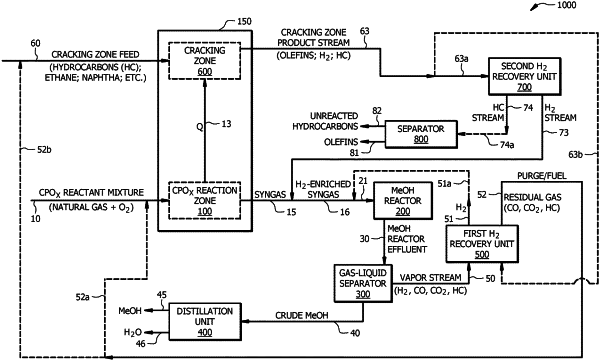| CPC C01B 3/382 (2013.01) [B01J 19/0013 (2013.01); B01J 19/245 (2013.01); C07C 4/04 (2013.01); C07C 29/1518 (2013.01); B01J 2219/0004 (2013.01); B01J 2219/00074 (2013.01); C01B 2203/0244 (2013.01); C01B 2203/0261 (2013.01); C01B 2203/0833 (2013.01); C01B 2203/1247 (2013.01); C01B 2203/148 (2013.01)] | 16 Claims |

|
1. A process for producing syngas and olefins comprising the following steps:
(a) feeding a catalytic partial oxidation (CPO) reactant mixture to a CPO reaction zone; wherein the CPO reactant mixture comprises oxygen, first hydrocarbons, and optionally steam; wherein at least a portion of the CPO reactant mixture reacts, via an exothermic CPO reaction, in the CPO reaction zone to produce syngas; wherein the CPO reaction zone comprises a CPO catalyst; wherein the syngas comprises hydrogen (H2), carbon monoxide (CO), carbon dioxide (CO2), water, and unreacted first hydrocarbons, and wherein the syngas is characterized by an M ratio of the syngas, wherein the M ratio is a molar ratio defined as (H2−CO2)/(CO+CO2);
(b) feeding a cracking zone feed to a cracking zone, wherein the cracking zone feed comprises second hydrocarbons; wherein at least a portion of the second hydrocarbons undergoes an endothermic cracking reaction in the cracking zone to produce a cracking zone product stream; wherein the first hydrocarbons and the second hydrocarbons are the same or different; wherein the cracking zone product stream comprises olefins, hydrogen, and unreacted second hydrocarbons; and
(c) cooling the CPO reaction zone; wherein cooling the CPO reaction zone comprises heating the cracking zone while cooling the CPO reaction zone by heat transfer between the CPO reaction zone and the cracking zone,
wherein the process further comprises the following steps: (1) separating at least a portion of the cracking zone product stream into a hydrogen stream and a hydrocarbons stream, wherein the hydrocarbons stream comprises olefins and unreacted hydrocarbons; (2) contacting at least a portion of the hydrogen stream with at least a portion of the syngas to produce a hydrogen-enriched syngas, wherein the hydrogen-enriched syngas is characterized by an M ratio greater than the M ratio of the syngas, and wherein the M ratio of the hydrogen-enriched syngas is equal to or greater than about 1.7.
|